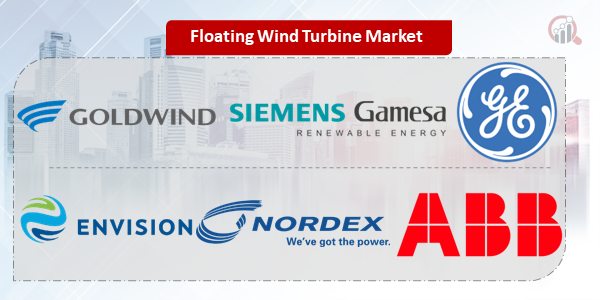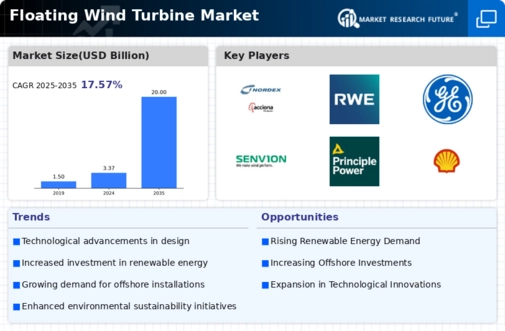Top Industry Leaders in the Floating Wind Turbine Market

*Disclaimer: List of key companies in no particular order
Top listed global companies in the Floating Wind Turbine industry are:
Goldwind
Siemens Gamesa Renewable
General Electric Company
Envision Energy
Nordex SE
MHI Vestas Offshore Wind
Senvion SA
Hitachi
ABB Group
Mingyang Smart Energy Group CO. Ltd.
Bridging the Gap by Exploring the Competitive Landscape of the Floating Wind Turbine Top Players
The floating wind turbine market is attracting a diverse set of players vying for a foothold in this burgeoning space. This dynamic landscape is characterized by established industry giants, innovative startups, and a confluence of strategic partnerships, all aiming to carve their niche in this new frontier of renewable energy.
Key Players and Strategies:
- Established Players: Global wind energy leaders like Siemens Gamesa, Vestas Wind Systems, and General Electric Renewable Energy are leveraging their existing expertise in turbine technology, supply chain networks, and financial muscle to secure early-mover advantages. Siemens Gamesa boasts the world's largest floating wind turbine, the SG 11MW, while Vestas emphasizes modularization and cost reduction strategies. GE Renewable Energy focuses on collaborating with local players to gain market access and adapt to regional regulations.
- Emerging Players: Startups like Principle Power, BlueFloat Energy, and Oceanwind are carving their niche through innovative designs and targeted solutions. Principle Power's semi-submersible platform offers increased stability and cost-efficiency, while BlueFloat Energy focuses on developing floating wind farms in deeper waters. Oceanwind's focus on nearshore deployments caters to specific geographic areas with limited landmass.
- Strategic Partnerships: Collaborations are a key theme, with established players joining forces with startups or local players. For instance, Siemens Gamesa partnered with Principle Power for the Hywind Tampen project in Scotland, while Vestas partnered with EDF Renewables for the FloatGen project in France. These collaborations leverage diverse strengths and expertise, accelerating technological advancement and project development.
Factors for Market Share Analysis:
- Technology Leadership: Offering turbines with higher capacity, improved efficiency, and design innovations for deeper waters and harsher environments will be crucial for market share gains. Companies like Siemens Gamesa with their SG 11MW and Vestas with their modular design approach are frontrunners in this aspect.
- Cost Reduction Strategies: Bringing down the Levelized Cost of Energy (LCOE) is paramount for market competitiveness. Investments in standardization, modularization, and efficient installation techniques will be critical. Startups like Principle Power and BlueFloat Energy are making strides in this area.
- Geographical Focus: Targeting specific regions with favorable wind resources and supportive regulatory frameworks is essential. Companies are strategically positioning themselves in areas like the North Sea, the Mediterranean, and the East Coast of the United States.
- Project Development and Execution: Securing permits, navigating complex regulations, and managing project risks effectively will differentiate successful players. Partnerships with local stakeholders and expertise in navigating the permitting process will be key differentiators.
Emerging Trends and Competitive Landscape:
- Floating Solar Hybrid Systems: Combining floating wind with solar panels on the same platform is gaining traction, offering optimized land utilization and increased power generation. Companies like Oceanwind and BlueFloat Energy are actively exploring this potential.
- Grid Integration and Storage Solutions: Integrating floating wind farms into existing grids and developing cost-effective storage solutions are critical for market expansion. Collaborations with grid operators and energy storage companies will be crucial for success.
- Digitalization and Automation: Utilizing advanced analytics, remote monitoring, and automation technologies will optimize operational efficiency and reduce maintenance costs. Companies like Siemens Gamesa and Vestas are investing heavily in these areas.
- Sustainability and Environmental Considerations: Minimizing the environmental impact of floating wind farms through responsible construction, operation, and decommissioning will be crucial for social acceptance and market growth. Companies are focusing on responsible material sourcing and ecological monitoring to address these concerns.
The Road Ahead:
The floating wind turbine market is poised for a thrilling ride, with constant innovation, strategic partnerships, and a focus on cost reduction and sustainability shaping the competitive landscape. Established players need to adapt their strategies to embrace new technologies and partnerships, while startups must leverage their agility and innovation to carve their niche. Ultimately, the companies that can navigate the currents of this dynamic market and deliver cost-effective, clean energy solutions will be the ones who ride the wave of success in the years to come.
Latest Company Updates:
Goldwind:
- October 26, 2023: Signed a memorandum of understanding with Ocean Winds, a joint venture between EDF Renewables and ENGIE, to collaborate on the development of floating wind projects in France. (Source: Goldwind website)
Siemens Gamesa Renewable Energy:
- October 17, 2023: Announced the launch of its SG 14-222 DD offshore wind turbine, the world's most powerful floating wind turbine with a capacity of 14 MW. (Source: Siemens Gamesa website)
General Electric Company (GE):
- September 20, 2023: Unveiled its Haliade-X 14 MW offshore wind turbine, designed for both bottom-fixed and floating applications. (Source: GE Renewable Energy website)
Envision Energy:
- July 18, 2023: Announced the development of the ENVISION-15 MW floating wind turbine, designed for deep-water applications. (Source: Envision Energy website)

